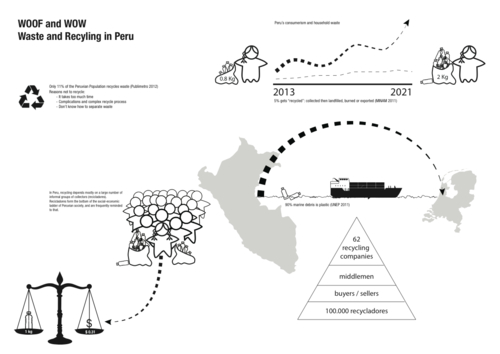This is mainly caused by one type of material: plastic. Almost all consumer goods contain plastic or are wrapped in plastic. The sandwich you eat, the lid of the coffee to go Plastic is a material that can’t be destructed naturally. When plastic is being made, it will always exist. Up until now there is no concrete technique to break down plastic.
In the western countries there are some recycle-techniques in order to make re-use of the plastic again.
In other countries in contradiction, there is no or almost no such system as recycling.
Plastic waste is a global issue which both affects human health and ecosystems. In particular aquatic ecosystems are severely affected by plastic waste; oceans full of plastic bottles exist nowadays.
Peru is one of the countries with the highest amount of plastic waste. From the marine debris 50% contains plastic. Almost none of this plastic waste is being recycled.
In order to make the problem clear you can have a look at the illustration below.
Figure 1: Schematic overview waste and recycling in Peru (WOOF and WOW)
At this moment (2013) an average household in Peru produces 0,8 kg waste. In 2021 this amount will be more than doubled en will be 2kg. Only 5% of this waste is being recycled (Ortiz, 2013). From all this waste plastic forms the greatest threat for the environment. Ecosystems are being disturbed by the plastic that can’t be degenerated by nature itself. Animals on top of the foodchain engulf the plastic and die, seas and streets are extreme filthy and other organisms as plants are being disrupted in their growing. In Peru the recycling value-chain starts with the underlayer of the informal ‘recicladors’ groups who assemble the plastic waste and sell it.
Aside from the pollution there is another serious problem that comes with this problem: there is no awareness amongst the Peruvian population. People in countries such as Peru aren’t aware of the fact that plastic pollution is a serious problem that affects their own health as well as the health of their ecosystems. Only 11% of the Peruvian population recycles plastic waste. The reasons why recycling is not executed is because people find that recycling takes too much time, they find the process too complex and they don’t know how to separate waste.
In 2012 The project ‘WOOF and WOW’ from the organisation Better Future Factory (BFF) started to work on the plastic pollution problem in Peru on invitation from the Unstable Media Insitute ‘V2’. Gaspard Bos and Charlot Boonekamp were given the opportunity to make a follow-up around plastic waste and product designing within the company Better Future Factory.
Together with the organisation L.O.O.P. (Life Out of Plastic) in Peru the project started. An extraordinary sublime technique is being used by local weavers from the Ruwasunchis community in Manchay to make products of plastic PET bottles. By this mean, plastic waste is incorporated in valuable products such as seatings and football nets.
Our contribution to this project is to do market research in Peru in order to find out what kind of products made of plastic waste are desired by the Peruvian population and to design useful prototypes which can be developed futher into products which can be sold in Peru and also in the Netherlands. In order to make a clear distinction between the activities of WOOF and WOW and our activities we will work under the name ‘Plastic Waste Lima Project’.
